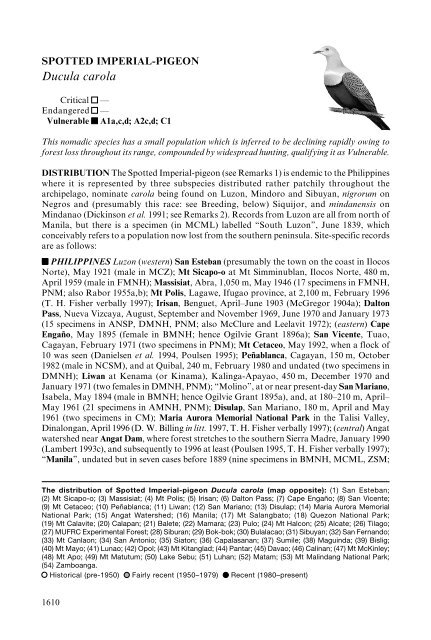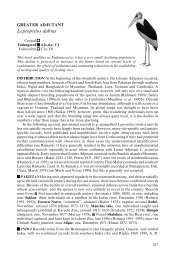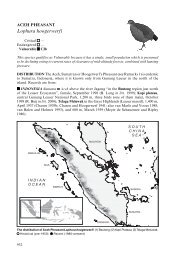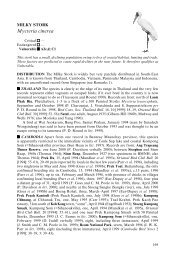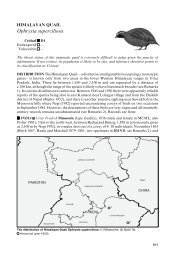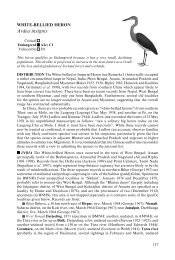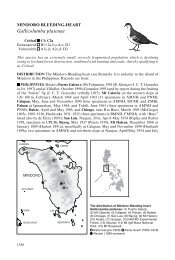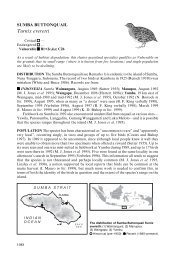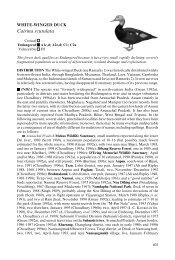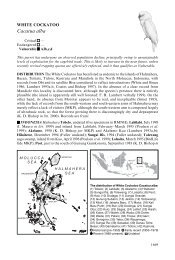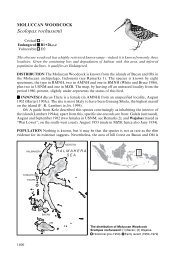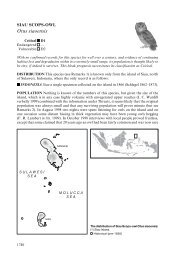Create successful ePaper yourself
Turn your PDF publications into a flip-book with our unique Google optimized e-Paper software.
Threatened birds of AsiaSPOTTED IMPERIAL-PIGEON<strong>Ducula</strong> <strong>carola</strong>Critical —Endangered —Vulnerable A1a,c,d; A2c,d; C1This nomadic species has a small population which is inferred to be declining rapidly owing toforest loss throughout its range, compounded by widespread hunting, qualifying it as Vulnerable.DISTRIBUTION The Spotted Imperial-pigeon (see Remarks 1) is endemic to the Philippineswhere it is represented by three subspecies distributed rather patchily throughout thearchipelago, nominate <strong>carola</strong> being found on Luzon, Mindoro and Sibuyan, nigrorum onNegros and (presumably this race: see Breeding, below) Siquijor, and mindanensis onMindanao (Dickinson et al. 1991; see Remarks 2). Records from Luzon are all from north ofManila, but there is a specimen (in MCML) labelled “South Luzon”, June 1839, whichconceivably refers to a population now lost from the southern peninsula. Site-specific recordsare as follows:■ PHILIPPINES Luzon (western) San Esteban (presumably the town on the coast in IlocosNorte), May 1921 (male in MCZ); Mt Sicapo-o at Mt Simminublan, Ilocos Norte, 480 m,April 1959 (male in FMNH); Massisiat, Abra, 1,050 m, May 1946 (17 specimens in FMNH,PNM; also Rabor 1955a,b); Mt Polis, Lagawe, Ifugao province, at 2,100 m, February 1996(T. H. Fisher verbally 1997); Irisan, Benguet, April–June 1903 (McGregor 1904a); DaltonPass, Nueva Vizcaya, August, September and November 1969, June 1970 and January 1973(15 specimens in ANSP, DMNH, PNM; also McClure and Leelavit 1972); (eastern) CapeEngaño, May 1895 (female in BMNH; hence Ogilvie Grant 1896a); San Vicente, Tuao,Cagayan, February 1971 (two specimens in PNM); Mt Cetaceo, May 1992, when a flock of10 was seen (Danielsen et al. 1994, Poulsen 1995); Peñablanca, Cagayan, 150 m, October1982 (male in NCSM), and at Quibal, 240 m, February 1980 and undated (two specimens inDMNH); Liwan at Kenama (or Kinama), Kalinga-Apayao, 450 m, December 1970 andJanuary 1971 (two females in DMNH, PNM); “Molino”, at or near present-day San Mariano,Isabela, May 1894 (male in BMNH; hence Ogilvie Grant 1895a), and, at 180–210 m, April–May 1961 (21 specimens in AMNH, PNM); Disulap, San Mariano, 180 m, April and May1961 (two specimens in CM); Maria Aurora Memorial National Park in the Talisi Valley,Dinalongan, April 1996 (D. W. Billing in litt. 1997, T. H. Fisher verbally 1997); (central) Angatwatershed near Angat Dam, where forest stretches to the southern Sierra Madre, January 1990(Lambert 1993c), and subsequently to 1996 at least (Poulsen 1995, T. H. Fisher verbally 1997);“Manila”, undated but in seven cases before 1889 (nine specimens in BMNH, MCML, ZSM;The distribution of Spotted Imperial-pigeon <strong>Ducula</strong> <strong>carola</strong> (map opposite): (1) San Esteban;(2) Mt Sicapo-o; (3) Massisiat; (4) Mt Polis; (5) Irisan; (6) Dalton Pass; (7) Cape Engaño; (8) San Vicente;(9) Mt Cetaceo; (10) Peñablanca; (11) Liwan; (12) San Mariano; (13) Disulap; (14) Maria Aurora MemorialNational Park; (15) Angat Watershed; (16) Manila; (17) Mt Salangbato; (18) Quezon National Park;(19) Mt Calavite; (20) Calapan; (21) Balete; (22) Mamara; (23) Pulo; (24) Mt Halcon; (25) Alcate; (26) Tilago;(27) MUFRC Experimental Forest; (28) Siburan; (29) Bok-bok; (30) Bulalacao; (31) Sibuyan; (32) San Fernando;(33) Mt Canlaon; (34) San Antonio; (35) Siaton; (36) Capalasanan; (37) Sumile; (38) Maguinda; (39) Bislig;(40) Mt Mayo; (41) Lunao; (42) Opol; (43) Mt Kitanglad; (44) Pantar; (45) Davao; (46) Calinan; (47) Mt McKinley;(48) Mt Apo; (49) Mt Matutum; (50) Lake Sebu; (51) Luhan; (52) Matam; (53) Mt Malindang National Park;(54) Zamboanga.Historical (pre-1950) Fairly recent (1950–1979) Recent (1980–present)1610
<strong>Ducula</strong> <strong>carola</strong>7P A C I F I CO C E A NSOUTH CHINA SEALUZON5132648910111213141516171819 2120222523 26 24282729303132SAMARPANAY33PALAWANSULU SEA34NEGROS363552534442414338373954MINDANAO4547 4648405049SABAH(MALAYSIA)S U CELEBES L W E S I SEA S E A511611
Threatened birds of Asiaalso Wardlaw Ramsay 1886, McGregor 1920), and occasionally down to 1905 (McGregor1905a); Mt Salangbato, Sta Maria, Laguna, April 1923 (two males in FMNH); Quezon NationalPark, February/March 1986 (Turton et al. 1986; hence Poulsen 1995);Mindoro Mt Calavite on the west slope, 180 m, February 1964 (male in PNM); Calapan,May 1890 (two specimens in ZMB); Balete, on the Baco river near Mt Halcon, March–May1905 (McGregor 1905c); Mamara, June 1972 (six specimens in PNM); Bojo (untraced), June1888 (male in BMNH); Pulo, Abra de Ilog, Mindoro Occidental, April 1969 (male in DMNH);Mt Halcon, April 1937 (Peters 1939), specifically Ilong Peak at 1,200–1,670 m, May 1954,with observations made at nearby Barrio Go-ob, May–June 1938 (Ripley and Rabor 1958),on the north slope at Arangin, July and August 1964 (three specimens in AMNH, PNM),and at Bignay, March 1937 (female in MCZ); Alcate, Victoria, 30 m, June 1969 (two males inDMNH); Malpalon, by report only (i.e. requiring confirmation) (Dutson et al. 1992); Tilago,Santa Cruz, 150 m, June 1966 (female in AMNH); MUFRC Experimental Forest, 1980(Catibog-Sinha 1982); Siburan (Sablayan on label), June 1950 (female in PNM); Bok-bok,Bongabong, 200 m, July 1963 (female in AMNH); Bulalacao, between May 1905 and February1906 (McGregor 1906a); Kamali-malihan (untraced), Mindoro Occidental, May 1971 (threespecimens in DMNH, PNM);Sibuyan unspecified locality, June 1904 (two specimens in FMNH; also McGregor 1905a);San Fernando, August 1928 (Baud 1976);Negros Mt Canlaon, April 1896 (Ogilvie Grant 1896c, Whitehead 1899d) and April–May1953, with one specimen taken as high as 2,210 m (Ripley and Rabor 1956); San Antonio,Sibulan, September 1952 (male in FMNH); Siaton at Sumaliring, July 1959 and 8 km to thenorth, July 1964 (two specimens in DMNH);Siquijor Capalasanan, Lazi, December 1952 (female in FMNH; also Rand and Rabor1960);Mindanao (eastern) Sumile at 100–500 m, November/December 1976 (Sanguila andTabaranza 1979); Maguinda, Agusan, at 50–100 m, November/December 1976 (Sanguila andTabaranza 1979); Bislig at the PICOP concession, February 1984 (Gibbs 1984), March 1990(Greensmith 1990), February 1994 (Hornbuckle 1994) and February 1997 (P. A. J. Morris inlitt. 1997); Mt Mayo, Limot, Mati, March and April 1949 (four specimens in PNM), June1965 (male in USNM); (central) Lunao, Gingoog City, 150 m, June 1980 (male in DMNH);Opol, Misamis Oriental, September 1951 (male in ZMC); Mt Kitanglad, unspecified area in1997 (F. Verbelen in litt. 1997), and at Malaybalay, April 1960 (two specimens, one at 1,500 m,in DMNH; also Ripley and Rabor 1961); Pantar, September 1903 (female in USNM); “Davao”,September 1908 (male in AMNH); Calinan (as “Catalnan”), March 1930 (four specimens inYIO); Mt McKinley on the east slope, 1,450–2,150 m, August and September 1946 (twospecimens in PNM); Mt Apo at Sibulan, early 1882 (Kutter 1883), at 2,400 m, March 1905(Ogilvie Grant 1906, Dickinson et al. 1991), and at Apo Lake and near Kidapawan, February1929 (nine specimens in DMNH and YIO; also Hachisuka 1930) and at Faggamb, February1929 (two specimens in AMNH and YIO); Mt Matutum, Tupi, 1,500 m, March 1962 (femalein AMNH), June 1966 (female in USNM), and at Balisong, Kablon, Tupi, September 1963(male in PNM); Lake Sebu at Sitio Siete, February 1986 (Fisher mss), 1993 (N. Bostock verbally1993), 1997 (F. Verbelen in litt. 1997); Luhan, New Dumangas, T’boli, South Cotabato, betweenmid-1984 and mid-1985 (Krupa et al. 1985); (western) Matam, Katipunan, May 1952 (twomales in FMNH); Mt Malindang at McMurray Flats, Grand Malindang Peak, 1,850 m, June1906 (male in USNM), and at Mt Bliss, 1,750 m, May 1906 (male in USNM); Zamboangatown, in the period March–May 1878 (Tweeddale 1878h).POPULATION This “flocking species” (Rand and Rabor 1960) is presumably uncommon(Dickinson et al. 1991), and certainly the number of recent (post-1990) localities is onlyseven (four in the Sierra Madre on Luzon, three on Mindanao).1612
<strong>Ducula</strong> <strong>carola</strong>Luzon The species was considered “fairly common” in parts of northern Luzon atthe end of the nineteenth century, its abundance or scarcity in any given locality dependingon the availability of fruit (Whitehead 1899d). A flock of 23 was observed in forest nearAngat Dam in 1990 (Lambert 1993c), flocks of 15–20 birds have been seen leaving roostsites on several occasions subsequently (T. H. Fisher verbally 1997) and 10 birds were seenin small flocks on Mt Cetaceo, where several other sightings of <strong>Ducula</strong> might have referredto this species (Danielsen et al. 1994). It is now apparently rare and local in the SierraMadre, where it was seen only once during four months of fieldwork in 1991 and 1992(Poulsen 1995).Mindoro A recent survey on Mindoro in 1991 failed to locate the bird, although it wasreported by a local at Malpalon (Dutson et al. 1992, Evans et al. 1993a, G. C. L. Dutson inlitt. 1996).Sibuyan There has been no record since 1928 (Baud 1976) despite recent surveys (Evanset al. 1993a, Goodman et al. 1995).Negros In 1896 the species was “commonly met with in flocks on the volcano of Canloon[sic] at an elevation of 6000 feet” (Ogilvie Grant 1896c). In the 1950s the species was stillrecorded as common at undisclosed sites near sea-level in the period September–November(Ripley and Rabor 1956). During a recent survey of Negros in 1991 the species was notfound (Brooks et al. 1992, Evans et al. 1993a).Siquijor There has been only the one record, in 1952, and no evidence of the species wasfound during a recent survey on the island in 1991 (Evans et al. 1993b).Mindanao Hachisuka (1932b) stated that he had often encountered this species onMindanao, but gave no further details. The only recent (1990s) reports for the entire islandare those from Mt Kitanglad (although not found during a 1992–1993 survey: Heaney et al.1993), Bislig and Lake Sebu, and indeed the species is thought to have declined at the last site(N. Bostock verbally 1994).ECOLOGY Habitat The Spotted Imperial-pigeon occurs in forest and forest edge from thelowlands to 2,000 m (Rand and Rabor 1960, Dickinson et al. 1991); however, although thereis one record from as high as 2,400 m on Mt Apo (see Distribution), in general the speciesappears to be more a bird of lower levels (which may explain its current rarity). In the SierraMadre it is confined to primary and selectively logged forest with closed canopy (>70%)(Danielsen et al. 1994). However, Rabor (1955b) reported that birds in the Abra highlandswould circle the forest in flocks before dawn, alighting in certain fruiting trees, but that assoon as sun lit the area they would set off towards the west, where they would reportedly becaught with lime in “stunted trees and shrubs growing abundantly on the uninhabited rockywindswept coasts”; in the daytime there would thus be only a few birds left behind, but in theevening (after sunset) the flocks would again appear flying in the vicinity (on cloudy daysthey would stay all day in the uplands).Food Delacour and Mayr (1946) reported birds taking large fruit and berries, often withconsiderable numbers gathering in fruiting trees, but the source of this information is notknown. Hachisuka (1931–1935) mentioned large seeds or nuts. Birds have been witnessedeating Eugenia fruit, and alighting in and almost certainly eating (though not positively seen)Ficus (Rabor 1955b). Evidence of witnesses (Whitehead 1899d, Rabor 1955b) indicates thatthis is a gregarious nomadic species that travels long distances in search of food; what foodthey might have found in the coastal habitat in which they were reported to be trapped (seeabove) is not known, although one idea is they descend into such habitat to bathe or drink insalt or fresh water, as do (or are reported to do) a few other pigeon species in Japan andSulawesi (D. Allen verbally 1997, D. Gibbs verbally 1998). On Mindoro in 1938 birds wereseen to come to fruiting trees in the early morning and late afternoon, with seemingly littlefeeding activity in the intervening period (Ripley and Rabor 1958).1613
Threatened birds of AsiaBreeding The fragments of information suggest a complex pattern perhaps varying betweenyears, but in general the season lasts from February to July. A male from Mindanao, February,and another from Mindoro, April, had enlarged testes, although two Mindanao femalesfrom February were less advanced (DMNH label data); a male from Luzon, April, andanother from Mindanao, May, had testes slightly enlarged (FMNH label data), two of fourspecimens taken on Mindoro in May were breeding, one being secured from a nest with oneegg (Ripley and Rabor 1958); a male from Mindanao, June, was undeveloped, while a femalewith an active ovary was taken in July on Negros (DMNH label data), although on the latterisland evidence of breeding was also obtained in April–May (Ripley and Rabor 1956). Thebird in FMNH from Siquijor, December, is small and lacks a brown belly, so is presumablyjuvenile (hence is difficult to attribute to race, as noted by Dickinson et al. 1991). The nestfound on Mindoro was “very peculiar because it was inside a small hollow on the side of ahigh perpendicular cliff, about 12 feet from the base” (Ripley and Rabor 1958); the reasonwhy this nest was so peculiar is not clear, since it appears to be the only one on record.Migration The daily movements described above and reported by Rabor (1955b) weredetected in May and claimed by local people on the Ilocos Sur coast to take place fromMarch to June. Similar daily movements were noted on Mt Canlaon, Negros, with birdsflying in flocks at enormous speed early each morning over the mountain top and descendingto lower elevations, presumably to feed (Whitehead 1899d). Records from Dalton Pass inthe period from August patchily to January suggest a further pattern of within-islandmovement on Luzon, some parts (at least) of the population travelling south into lowerareas for what is presumably the winter season. It is possible that this species is nomadic, orbecomes so when food supplies run short, and that it wanders rather widely, perhaps breedingopportunistically when it encounters appropriate conditions; this might explain the recordsfrom the smaller islands of the archipelago in the early part of this century. Certainly onNegros the record of a bird at 2,210 m in April/May was construed as evidence “that thisspecies is highly migratory locally since it is common near sea level during September, October,and November” (Ripley and Rabor 1956).THREATS Habitat destruction and hunting, both continuing, are blamed for this pigeon’sclearly serious diminution in number and contraction in range (Collar et al. 1994). Thedeliberate conflagration of forests on Mindanao—associated with insurgency—is a problem,particularly on the Zamboanga Peninsula (D. Allen verbally 1997), while at Bislig goodprimary forest is being clear-felled (under the PICOP logging concession) and the land plantedwith exotic trees for paper production (B. Gee in litt. 1997; also Caufield 1983). On Sibuyanwithin the Kuyasian Forest, March 1992, there was considerable logging activity, particularlyof the remaining large hardwoods, with the Atlas Mining Corporation on the neighbouringisland of Masbate being the biggest purchaser in spite of no legal logging concession existingon the island (Goodman and Ingle 1993, Goodman et al. 1995). The species appears to havea complex pattern of habitat and food resource use, and this greatly magnifies the risks itfaces, since it depends on such habitat and resources in many different places throughout theannual cycle: the patchier these elements become, the more difficult it must be for populationsto persist (which is now understood to be the cause of the extinction of the Passenger PigeonEctopistes migratorius: see Bucher 1992). The hunting of the species is greatly facilitated byits habit of congregating at predictable sites (Manuel 1953), and on the Ilocos Sur coast localpeople reported to Rabor (1955b) that “great numbers” would be caught with lime and sentto large markets in the province. McGregor (1905b) reported that birds from the vicinity ofManila would occasionally be brought “into the markets here alive”.MEASURES TAKEN The Spotted Imperial-pigeon has been found in four CPPAP sites(Northern Sierra Madre Natural Park on Luzon; Mt Canlaon on Negros; Mts Kitanglad1614
<strong>Ducula</strong> <strong>carola</strong>and Apo on Mindanao) and one NIPAP site (Mt Malindang on Mindanao; see Appendix).Conservation-related activities on Mt Matutum are supported by FPE funding, and the MtTalinis/Twin Lakes area on Negros (including the Eastern Cuernos de Negros and LakeBalinsasayao “key sites”) —close to the San Antonio area—is proposed for action under thesame programme (see Appendix). The MUFRC Experimental Forest on Mindoro covers7,853 ha (Catibog-Sinha 1982) and protects an area of forest suitable for the species, as doQuezon National Park and the Maria Aurora MNP on Luzon, although the long-term outlookfor these sites is unknown. The largest tract of lowland forest known on Mindoro is at Siburan(see Appendix) although it is not clear how much of the area receives protection from anadjacent penal colony or from the F. B. Harrison Game Reserve (Dutson et al. 1992).However, if this species is dependent on several different areas throughout its annual cycle,these measures may not be sufficient; and if it utilises food resources opportunistically itmay prove very difficult indeed to offer any long-term protection for it through conventionalmeans.MEASURES PROPOSED Apart from the areas targeted for conservation above, the specieshas been recorded from sites in or near seven “key sites” (Angat Watershed and Mt Polis onLuzon; Mt Halcon and possibly Lake Naujan on Mindoro; Mt Bandila-an on Siquijor; MtsMayo and Three Kings on Mindanao; see Appendix P) and these deserve further survey and,at least in part, formal designation under the NIPAS process. In order to assess its status andto enable the formulation of a workable conservation management plan, the species needs tobe surveyed in its historical range so that information can be gathered on status, distributionand ecology; radio-tagging birds would be exceptionally helpful in understanding theirseemingly complex daily and seasonal movements.REMARKS (1) The affinities of this species are not clear, but it has been judged most likelyto be an aberrant offshoot of the poliocephala species-group of <strong>Ducula</strong> pigeons, which includesthe threatened mindorensis (Goodwin 1960). (2) The validity of these subspecies is worthreviewing; McGregor (1905c) found traits in certain populations linking them to others, andthe fact that the species appears to wander widely implies that some introgression occurs.1615


